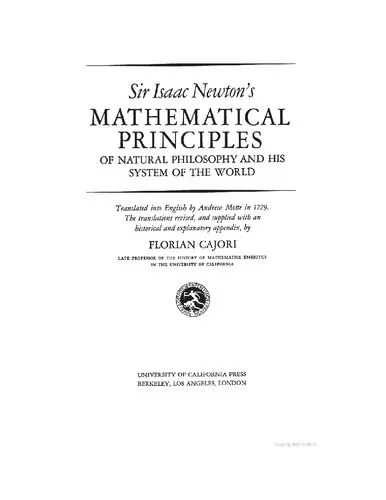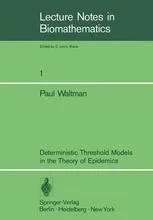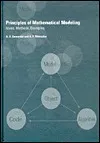Mathematical Epidemiology
4.5
Reviews from our users

You Can Ask your questions from this book's AI after Login
Each download or ask from book AI costs 2 points. To earn more free points, please visit the Points Guide Page and complete some valuable actions.Related Refrences:
Introduction to Mathematical Epidemiology
Mathematical Epidemiology delves into one of the most fascinating intersections of applied mathematics and public health: the quantitative analysis of infectious diseases. This comprehensive book, edited by Fred Brauer, Pauline van den Driessche, and Jianhong Wu, and featuring contributions from experts like David J.D. Earn, provides readers with a thorough understanding of how mathematical models are applied to study the spread of diseases. Fit for mathematicians, epidemiologists, and public health professionals alike, the book establishes a robust foundation in the modeling, analysis, and prediction of epidemiological dynamics while addressing real-world challenges and applications.
The study of mathematical epidemiology is essential in understanding and managing disease outbreaks. Infectious diseases evolve rapidly, and mathematical frameworks allow us to simulate different scenarios, forecast disease progression, and evaluate strategies to mitigate the impact. By uniting rigorous mathematics with real-world applications, this book provides readers with the tools they need to transform theoretical knowledge into actionable insights.
Summary of the Book
Mathematical Epidemiology is divided into sections that address various fundamental and advanced concepts. The text opens by introducing readers to the basics of disease modeling, including common models such as the SIR (Susceptible-Infectious-Recovered) and SEIR (Susceptible-Exposed-Infectious-Recovered) frameworks. Each chapter builds upon foundational knowledge while diving deeper into specialized topics like herd immunity, vaccination strategies, and stochastic modeling approaches. The contributors present illustrative examples and model simulations to bridge theory and practice, emphasizing the relevance of mathematical methods in real epidemiological investigations.
Advanced sections of the book explore more complex topics such as spatial modeling, delay equations, and the incorporation of multi-strain pathogens. These concepts are critical when studying diseases that evolve over time, such as influenza or SARS-CoV-2. This progression from introductory to advanced material makes the book a valuable resource for learners and experienced professionals alike. Not only is the content intellectually stimulating, but it is also immensely practical, with applications to real-life case studies spanning global outbreaks and policy analysis.
Key Takeaways
- Mathematical models are invaluable tools for understanding, predicting, and mitigating the spread of infectious diseases.
- Foundational concepts like the basic reproduction number (R0) are central to evaluating disease transmissibility and intervention strategies.
- Advanced modeling techniques such as delay differential equations and stochastic approaches provide more realistic insights into disease progression.
- Interdisciplinary collaboration is essential in mathematical epidemiology, bridging mathematics, biology, public health, and policy-making.
- The book emphasizes the critical role of data-informed modeling in shaping global health interventions and containing pandemics.
Famous Quotes from the Book
"Mathematical models are simplifications of reality, but they remain our most powerful tools to frame, analyze, and predict the outcomes of epidemics."
"Epidemiological modeling is as much an art as a science; it requires choosing what features of an epidemic to prioritize while navigating the inconsistency of real-world data."
"From vaccination to quarantine, mathematical epidemiology offers insights that extend beyond prediction, offering strategies to save lives."
Why This Book Matters
In a world increasingly vulnerable to pandemics and emerging infectious diseases, the importance of mathematical epidemiology cannot be overstated. Mathematical Epidemiology provides a vital foundation for understanding how infectious diseases spread and how they can be controlled. Its timely relevance extends to global events such as the COVID-19 pandemic, where mathematical models have been crucial in guiding public health decisions.
The book also emphasizes the interdisciplinary nature of the field, showing how mathematics and biology converge to solve urgent problems. This integration of disciplines is not only inspiring but also necessary for tackling complex challenges. Moreover, by addressing advanced topics alongside practical applications, the book ensures that readers gain both theoretical insights and pragmatic tools for disease management.
Ultimately, this book serves a dual purpose: to inspire greater understanding of infectious diseases and to equip professionals with the tools they need to combat health crises on a global scale. Whether you are a student, a researcher, or a policymaker, Mathematical Epidemiology offers invaluable knowledge that can change how you perceive and respond to outbreaks.
Free Direct Download
You Can Download this book after Login
Accessing books through legal platforms and public libraries not only supports the rights of authors and publishers but also contributes to the sustainability of reading culture. Before downloading, please take a moment to consider these options.
Find this book on other platforms:
WorldCat helps you find books in libraries worldwide.
See ratings, reviews, and discussions on Goodreads.
Find and buy rare or used books on AbeBooks.
1374
بازدید4.5
امتیاز0
نظر98%
رضایتReviews:
4.5
Based on 0 users review
Questions & Answers
Ask questions about this book or help others by answering
No questions yet. Be the first to ask!















